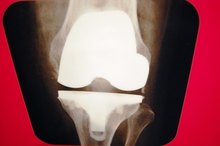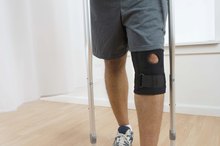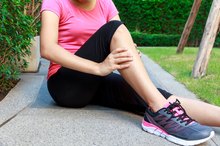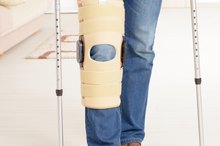Tightness and Pain Behind the Knees
Much like the god Atlas of Greek mythology, the job of the knee joint is to bear weight. As a weight bearer, the knee is subject to athletic, overuse and arthritic injury. Because of the joint's complex array of bone, muscle, cartilage and ligaments, pain or stiffness can be an indication of other maladies arising from vascular and cystic conditions or resulting from tumors. Any discomfort should be taken seriously and thoroughly investigated.
If you are experiencing serious medical symptoms, seek emergency treatment immediately.
Response to Injury
Athletic injuries from overextension of the knee, as with martial arts kicks or landing awkwardly during jumping, can damage the posterior cruciate ligament, or PCL 1. The PCL attaches the femur -- the bone connecting the pelvis and knee -- to the tibia, the bone running from knee to ankle. It prevents the tibia from moving behind the femur. The PCL can also be injured from a car accident when a bent knee is forcefully hit, as on a dashboard. Symptoms include swelling and pain in the popliteal fossa -- the space behind the knee. Dislocations of the knee, though uncommon, run the risk of damaging the blood vessels behind the knee, particularly the popliteal artery.
- Athletic injuries from overextension of the knee, as with martial arts kicks or landing awkwardly during jumping, can damage the posterior cruciate ligament, or PCL 1.
- Dislocations of the knee, though uncommon, run the risk of damaging the blood vessels behind the knee, particularly the popliteal artery.
Vascular Effects
Knee Cap Pain & Swelling
Learn More
Blood vessel damage in the knee is particularly dangerous, because irreversible ischemia -- poor blood flow -- to the knee can occur in as little as 6 hours. This is why injury to the popliteal artery, when left untreated, has an amputation rate of 30 percent. Other reasons for emergent surgical evaluation of the knee would be lack of a detectable pulse and unrelenting pain behind the knee, which could be a sign of an expanding clot of blood, or hematoma. Even without injury, the popliteal artery wall can weaken and expand, resulting in an aneurysm. Aneurysm may present with no symptoms or with pain in the knee that increases with prolonged standing.
- Blood vessel damage in the knee is particularly dangerous, because irreversible ischemia -- poor blood flow -- to the knee can occur in as little as 6 hours.
- Other reasons for emergent surgical evaluation of the knee would be lack of a detectable pulse and unrelenting pain behind the knee, which could be a sign of an expanding clot of blood, or hematoma.
An Arthritic Origin
Osteoarthritis is a degenerative joint disease resulting from aging. Knee osteoarthritis is a major cause of disability in those 65 and older and results in joint stiffening and pain. It is also commonly associated with Baker cysts. A Baker cyst is a herniation, or outpouching, of the fluid-filled cushion of the knee. Symptoms of Baker cysts depend on their size, but pain and swelling in the popliteal fossa are common. Baker cyst may also be an indication of an underlying tear in the meniscus -- the cartilage that cushions the knee. A burst Baker cyst can lead to infection and hemorrhage within the knee, so it requires medical attention.
- Osteoarthritis is a degenerative joint disease resulting from aging.
- A burst Baker cyst can lead to infection and hemorrhage within the knee, so it requires medical attention.
When to See a Doctor
Symptoms of an Aneurysm Behind the Knee
Learn More
In any case of prolonged pain or stiffness in the knee joint, a doctor should be consulted. Missed meniscal or cruciate ligament tears can lead to complete dislocation of the knee joint. Vascular damage from trauma or aneurysms can lead to ischemia and amputation if untreated. Baker cysts do not usually result in long-term harm, but they can be painful and a sign of underlying joint damage. An evaluation by a doctor employing an ultrasound of the joint or magnetic resonance imaging will quickly identify the cause of the discomfort and appropriate treatments.
- In any case of prolonged pain or stiffness in the knee joint, a doctor should be consulted.
- Missed meniscal or cruciate ligament tears can lead to complete dislocation of the knee joint.
Related Articles
References
- Journal of Special Operations Medicine: Dislocation of the Knee -- Imaging Findings
- Romanian Journal of Morphology & Embryology: A Complex Assessment of Patients With Knee Osteoarthritis and Baker’s Cyst: Observational Study
- MedlinePlus: Baker's Cyst
- Lespasio MJ, Piuzzi NS, Husni ME, Muschler GF, Guarino A, Mont MA. Knee Osteoarthritis: A Primer. Perm J. 2017;21:16-183. doi:10.7812/TPP/16-183
- Kiapour AM, Murray MM. Basic science of anterior cruciate ligament injury and repair. Bone Joint Res. 2014;3(2):20-31. doi:10.1302/2046-3758.32.2000241
- Doral MN, Bilge O, Huri G, Turhan E, Verdonk R. Modern treatment of meniscal tears. EFORT Open Rev. 2018;3(5):260-268. doi:10.1302/2058-5241.3.170067
- Reinking MF. CURRENT CONCEPTS IN THE TREATMENT OF PATELLAR TENDINOPATHY. Int J Sports Phys Ther. 2016;11(6):854-866.
- Petersen W, Rembitzki I, Liebau C. Patellofemoral pain in athletes. Open Access J Sports Med. 2017;8:143-154. doi:10.2147/OAJSM.S133406
- Frush TJ, Noyes FR. Baker's Cyst: Diagnostic and Surgical Considerations. Sports Health. 2015;7(4):359-65. doi:10.1177/1941738113520130
- Huang YC, Yeh WL. Endoscopic treatment of prepatellar bursitis. Int Orthop. 2011;35(3):355-8. doi:10.1007/s00264-010-1033-5
- Beals C, Flanigan D. A Review of Treatments for Iliotibial Band Syndrome in the Athletic Population. J Sports Med (Hindawi Publ Corp). 2013;2013:367169. doi:10.1155/2013/367169
- Tsai CH, Hsu CJ, Hung CH, Hsu HC. Primary traumatic patellar dislocation. J Orthop Surg Res. 2012;7:21. doi:10.1186/1749-799X-7-21
- Ragab G, Elshahaly M, Bardin T. Gout: An old disease in new perspective - A review. J Adv Res. 2017;8(5):495-511. doi:10.1016/j.jare.2017.04.008
- Lee PYF, Nixion A, Chandratreya A, Murray JM. Synovial Plica Syndrome of the Knee: A Commonly Overlooked Cause of Anterior Knee Pain. Surg J (N Y). 2017;3(1):e9-e16. doi:10.1055/s-0037-1598047
- Vaishya R, Azizi AT, Agarwal AK, Vijay V. Apophysitis of the Tibial Tuberosity (Osgood-Schlatter Disease): A Review. Cureus. 2016;8(9):e780. doi:10.7759/cureus.780
- Zanon G, Di vico G, Marullo M. Osteochondritis dissecans of the knee. Joints. 2014;2(1):29-36.
- Hindle P, Davidson E, Biant LC. Septic arthritis of the knee: the use and effect of antibiotics prior to diagnostic aspiration. Ann R Coll Surg Engl. 2012;94(5):351-5. doi:10.1308/003588412X13171221591015
- Gwinner C, Märdian S, Schwabe P, Schaser KD, Krapohl BD, Jung TM. Current concepts review: Fractures of the patella. GMS Interdiscip Plast Reconstr Surg DGPW. 2016;5:Doc01. doi:10.3205/iprs000080
- Voskuil R, Evenski AJ, Montgomery C, Emory CL. Malignant Bone Tumors of the Knee: How to Identify and Treat. J Knee Surg. 2019;32(4):305-314. doi:10.1055/s-0038-1675828
- Gupte C, St mart JP. The acute swollen knee: diagnosis and management. J R Soc Med. 2013;106(7):259-68. doi:10.1177/0141076813482831
- American Academy of Orthopedic Surgeons. Unstable Kneecap.
- Bhatia D, Bejarano T, Novo M. Current interventions in the management of knee osteoarthritis. Journal of Pharmacy & Bioallied Sciences 2013 Jan-Mar;5(1):30-38. doi:%2010.4103/0975-7406.106561
- Bronstein RD, Schaffer JC. Physical Examination of the Knee: Meniscus, Cartilage, and Patellofemoral Conditions. J Am Acad Orthop Surg. 2017 May;25(5):365-374.
- Browne K, Kurtz CA. How to perform a comprehensive examination of the knee. JAAPA. 2009 Jun;22(6):20-25.
- Hergenroeder AC, Harvey BS. (2017). Osteochondritis dissecans (OCD): Clinical manifestations and diagnosis. Bachur RG, ed. UpToDate. Waltham, MA: UpToDate Inc.
Writer Bio
Bernadette Hromin has been a practicing ophthalmologist in the New York area for more than 10 years. Having a professional fluency in Spanish, she writes a blog which educates health care workers in the bilingual clinical environment. As an eye doctor, Bernadette is a stickler about eating one green vegetable daily.








